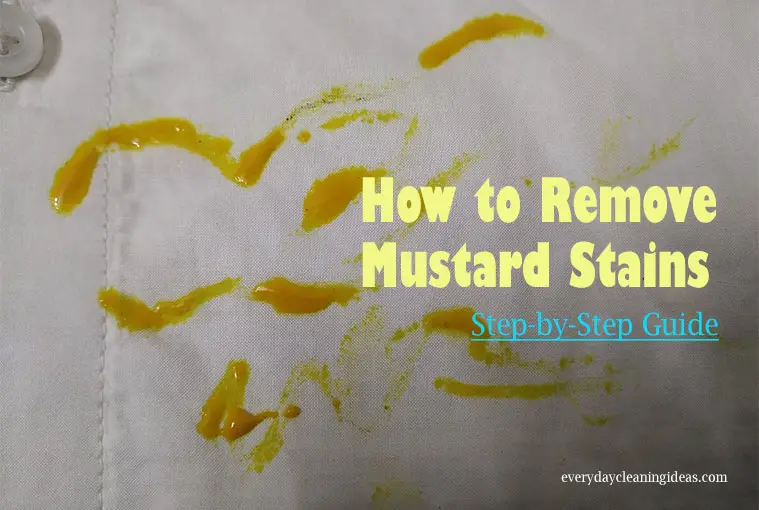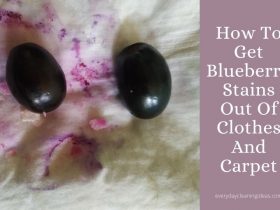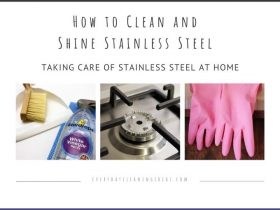We’ve all been there, staring at a mustard stain even after being extra careful. These stains can be as stubborn as ketchup, and difficult to get rid of.
As difficult as it is to predict a stain on your favorite clothes or carpet, it’s easier to remove them than you think. We got you covered with simple home remedies for mustard stains.
Mustard stain removal will be a pain if you don’t treat it immediately. The turmeric content in mustard sauce is hard to get rid of once it sets in.
Whether it’s on your colored clothes or your white shirt, do consult the wash label first.
Once you’re sure of the wash care instructions, get down to removing the excess mustard.
Simply use a blunt object to scrape off the surface residue, if any. Blotting with an absorbent, dry piece of cloth will also work.
The following treatments will depend on the stained item. Make sure to take into account the kind of material the mustard has stained and if it can handle the solutions provided below.
Clothing Stains
Before you choose an appropriate stain removal method for your clothing, consider these-
- Take a look at the wash care label. Is it washable/non-washable? Can you use a harsher method to treat the stain?
- Patch test a bit of a stain removal treatment on a corner of your stained garment. Is the color steadfast or transferring? Is it harsh for your clothing?
- Some clothing items tend to be too delicate for washing. Don’t try pretreatment for them.
- How fresh is the stain?
If you use the blotting technique, make sure to secure the backside of the stain. The stain shouldn’t transfer to the clean side of your clothing.
Washable Clothing
If it’s washable, immerse the stain in cold, running water and let the water run through the stain. Do this on both sides of the stain to remove any mustard, leftover from scraping.
If you have a stain removal kit at home, wonderful! Pour it into the stain and follow the instructions on the label.
Check for ammonia in the product. They tend to react with mustard stains and make them worse.
If you don’t have a stain removal liquid, do read on.
Mustard Stains are best treated with-
- Rubbing alcohol
- Liquid dish soap/detergent
- Soap bar
- White vinegar
You may use each of them mixed only with lukewarm water.
You may also try combining one part rubbing alcohol, three parts liquid dish soap with warm water as pretreatment.
Removing mustard stains with vinegar is also possible. Use white vinegar. You need to use the blotting method for this one.
Combine liquid dish wash soap, a few drops of Vinegar, and water. Use a clean piece of absorbent cloth to dip into the solution and dab the stain.
Rubbing alcohol and white vinegar isn’t suitable for fragile clothing like silk and satin. These tend to make the mustard stains worse for such materials.
Wash the clothing immediately after treating the stain. Use hot water for light-colored cotton clothes. Keep reducing the temperature for the delicates.
Non-Washable Clothing
Presumably, such clothing is usually meant to be dry-cleaned and needs extra care while choosing a treatment solution.
Perform the scraping with any blunt, thin object. Plastic or metal knives, spoons will work.
Check if you have these at home or buy them from your local supermarket-
- Hydrogen Peroxide
- Ammonia
- Dry cleaning treatment
- White vinegar
If you have a dry cleaning solvent go for it. Simply pour it on the stain and let it sit for a few minutes (as pretreatment).
This is a good choice for stains on leather or suede garments. Make sure to only use leather friendly cleaners which don’t damage the leather.
For tougher fabrics, use a brush to blot out the stain. Do not use water to wash away the solvent, reapply the treatment again, and blot it. Then send it for dry cleaning.
Ammonia isn’t suitable for delicates but if you use a drop of it with hydrogen peroxide, it won’t harm your clothes. It acts as a bleaching agent for the stain. Avoid using it on satin, silk, and woolens.
Stick to the safety of 15 minutes and rinse out the area with cold water and put it out for drying.
Make sure to mix the two ingredients in a well-ventilated room. Inhaling the noxious fumes from combining them might make you sick.
Vinegar is for tougher fabrics and stains as well. Use a cotton pad or sponge to lightly stroke the stain until it’s completely gone.
Tamp it with the sponge for deeper stains and flush it out with water (dab the stain).
Hot water makes a stain worse, especially if you discover it after washing your stained clothing.
In case the stain is older and ingrained into your clothes, you might need to repeat the treatment more than twice.
Carpet Stains
Now that you found a stain, don’t wait to treat it. Get working on it right away. You may also use this section to treat the stains on your upholstery.
Similar to clothing, check out if your carpet is washable. If it’s washable it’s always good to launder them after treating the stain.
Before you choose one of the methods to use on your carpet or upholstery, do a patch test. We don’t want you ruining an expensive carpet by trying any home treatment.
Consider these for removing carpet stains-
- Liquid detergent/dish soap
- Commercial solvent
- Mustard (we’ll explain why)
Before you begin the treatment, make sure to scrape off any excess mustard with a thin blunt object. Use a blunt edge of a knife, if you don’t have a butter knife.
This might sound weird, but if you are dealing with an old stain, try applying a blob of mustard on it. This helps the dry stain moisten up enough to get removed with scraping. Let it stand for about five minutes and start scraping.
Now, to the pretreatment. Dilute dish wash soap and use a clean piece of cloth dipped in it to dab the stain. You can also use a sponge instead of a cloth.
Once the stain disappears, make sure to pat with a dry cloth. Try pressing the cloth into the treated area to check if it’s indeed gone.
Go for a commercial enzyme-based solvent if the stain is tougher. They aren’t toxic and their biodegradable nature is good for using around the house, especially if you have children.
Hard Surfaces
Did mustard end up like splatter paint on the wall or the floor? Get working on it immediately.
Try warm soapy water for vinyl, plastic, asphalt, and acrylic surfaces or material. This will also work for hardwood floors and wallpapers.
Make sure to clean off with a dry towel or cloth after wiping the stain with soapy water. It’s suggested you go for polishing or waxing your wooden floors, once the area dries.
For chalky, cork, or metal surfaces, go for light scraping. Try the same method as above and quickly dry it using a soft cloth.
If the stain persists, try applying the solution with a hard-bristled toothbrush or a brush with thinner strands. Stroke the stained area to completely remove the stain.
Try these simple and effective solutions to treat mustard stains at home. You can restore your apparel, upholstery, or any stained surface quickly with these readily available items.
More related topics –









Leave a Reply
View Comments